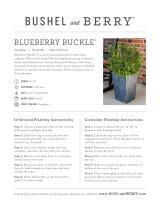Page is loading ...

Planting and Care of Blueberry Plants
Blueberries are increasingly popular fruits with well-documented health benefits. Blueberry
plants are also exceptionally handsome bushes worthy of planting in the home landscape. The
fruit can be eaten fresh or frozen. Plants have a profusion of white blossoms in late spring, and
the leaves are glossy green in summer. In fall the leaves change to bright shades of red, orange
and yellow. Following the simple care instructions below, your new blueberry plants will
quickly become beautiful and productive additions to your yard and garden.
Site Selection
Blueberries grow best in a sunny location with well drained soil. Plants will tolerate partial
shade, preferring at least six hours of sun a day. Avoid areas surrounded by trees, which
provide too much shade, compete with plants for water and nutrients, and interfere with air
movement around plants. Poor air movement increases danger of spring frost injury to
blossoms and favors disease development.
Soil Preparation
Blueberry plants grow best in acid soils (pH 4.0 to 5.5) that are well-drained, loose, and high in
organic matter. Blueberry plants can be grown anywhere Azaleas and Rhododendrons will
grow.
If the pH of the soil is between 5.5 and 7.0, and the texture is sandy to sandy loam, the addition
of acid peat is all that will be needed to prepare the soil. Mix 4 to 6 inches of acid peat into the
top 6 to 8 inches of soil. In addition to acidifying the soil, the peat increases the soil organic
matter content.
Different sulfur compounds can be used to acidify the soil as well. For 50 cubic feet of sandy soil
(the amount of soil in a space 10 feet by 10 feet by 6 inches), use one to two pounds of
elemental sulfur to reduce the pH one point. You will need to use three to six pounds to get the
same effect in loam soils. Aluminum sulfate is not recommended, although it can acidify soil,
because high rates of this compound can be toxic to roots.
Planting
Plant young blueberry bushes 3 to 4 feet apart. Remove the plant from the pot and lightly
roughen up the outside surface of the root ball. Plants should be set at the same depth or
slightly higher than the existing ground. Pack the soil firmly around the roots, then mulch the
planting with 2 to 4 inches of sawdust, peat moss, or chopped straw. Surface mulch helps

maintain uniform soil moisture and good soil structure, and it reduces soil temperature in the
summer. Replenish the mulch as needed. Water the planting frequently enough to keep the soil
moist but not saturated throughout the life of the planting.
Care of Plants
In the first two years, remove flowers in the spring to encourage vegetative growth.
Encouragement of vegetative growth is essential for healthy plants in the following years. A
good-sized, healthy canopy is needed to support the fruit.
The need for fertilizer will be indicated by plant growth and foliage color. Generally one
application of an acid-producing fertilizer in early spring will be sufficient. Blueberries are in the
same plant family as azaleas and rhododendrons, and an azalea fertilizer formulated for acid-
loving plants works well for a small planting. Follow the manufacturer’s instructions as to
amount and method of application.
Pruning
The objectives of pruning are to remove dead and diseased wood, shape the bush and maintain
an adequate number of vigorous main stems to produce large berries. Pruning new bushes is
needed only to remove any dead or dying parts of branches. After the fifth year, prune the
bushes annually in the early spring, just before growth starts.
Fruit is produced on one-year-old wood. The largest berries are produced on the most vigorous
wood, so a good supply of strong, one-year-old wood is desirable. Keep the bush fairly open by
cutting out any weak, old stems that no longer produce strong young wood. Remove these
older stems at ground level. Keep four to six of the vigorous older stems and one to two strong
new shoots per mature bush. The new shoots will eventually replace the older stems.
Pests
Blueberries are very attractive to birds. Birds can eat the entire crop off a small planting if it is
not protected. Covering the individual bushes or the entire planting with netting supported by a
light frame is the best protection. Secure the netting so there is no place for the birds to enter.
The fruit ripens over a three week period, and you will have to remove the netting to harvest.
The netting should not shade the plants or they will not flower well the following year. Be sure
to completely remove the netting after harvest.
Insects and diseases are not likely to cause problems with most plants. Careful pruning will help
prevent disease infection. Prune out and destroy any part of the plant that is dead or dying.
/





